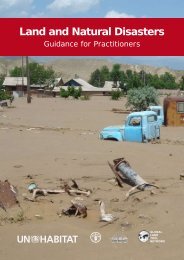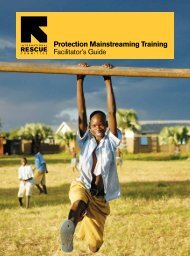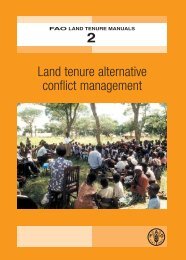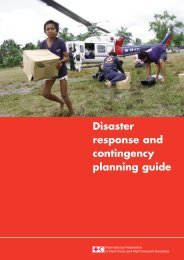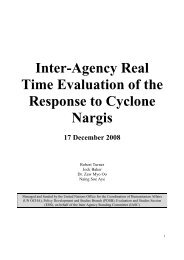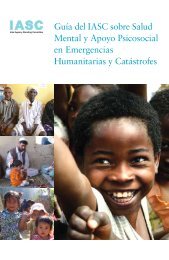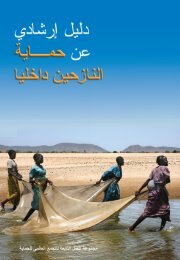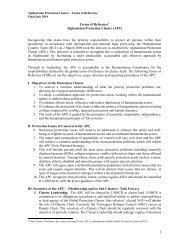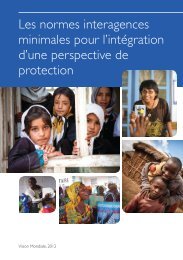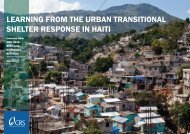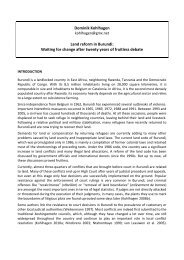Mid-Year Review of the Work Plan for Sudan 2012 - Global ...
Mid-Year Review of the Work Plan for Sudan 2012 - Global ...
Mid-Year Review of the Work Plan for Sudan 2012 - Global ...
You also want an ePaper? Increase the reach of your titles
YUMPU automatically turns print PDFs into web optimized ePapers that Google loves.
16[1] 2011 IN REVIEW | SUMMARY OF RESPONSE TO DATE UNITED NATIONS AND PARTNERSSUDAN WORK PLAN <strong>2012</strong>SUMMARY OF RESPONSE TO DATEThe humanitarian situation in <strong>Sudan</strong> requires a large and multisectorresponse to meet <strong>the</strong> significant level <strong>of</strong> humanitarianneeds. In <strong>2012</strong>, up to 3,800 NNGOs, 125 INGOs, <strong>the</strong>International Red Cross/Red Crescent movement, 21 Donors,22 Government line ministries, and 26 UN Agencies, Fundsand Programmes will provide assistance across 12 sectorsin <strong>Sudan</strong>. The following section provides an overview <strong>of</strong> <strong>the</strong>humanitarian response during <strong>2012</strong>, as well as some <strong>of</strong> <strong>the</strong>major implementation challenges facing sectors.SUMMARY OF RESPONSEHumanitarian actors play a key role in ensuring vulnerablepeople in <strong>Sudan</strong> receive life-saving assistance, have access tobasic services and can rebuild <strong>the</strong>ir lives with dignity. During<strong>the</strong> first half <strong>of</strong> <strong>2012</strong>, <strong>the</strong> sectors have made a significantcontribution to providing life-saving assistance in <strong>Sudan</strong>. Thescale and range <strong>of</strong> humanitarian assistance is illustrated in <strong>the</strong><strong>Sudan</strong>diagram below.Food Security and Livelihoods• 1.9 million receive food assistance.• 172,000 people with livelihood support.• 2.2 million livestock supported.Nutrition• 327,000 children screened <strong>for</strong> malnutrition.• 32,719 treated <strong>for</strong> SAM; 18,210 <strong>for</strong> MAM• 58 Outpatient/Inpatient centers openedWASH• Over 750,000 have improved access to safe water• 2.1 million with sustained safe water access overall.• 241,000 access to improved sanitation.• 1.7 million served with waste management.• 1.9 million people reached with hygiene messages.Jun-12Summary <strong>of</strong>ResponseUnited NationsHealth• 73% people covered by functioning healthfacility.• 66% have access to basic health package.• 100% response to communicable diseaseoutbreak.Education• 60,000 extra school children enrolled.• 197,000 children have improved access toquality education.Protection and Returns• Verified voluntary return <strong>of</strong> 38,000 people in Darfur.• Supported issuance <strong>of</strong> 20,000 emergency traveldocuments <strong>for</strong> South <strong>Sudan</strong>ese.• Family tracing and reunification system operationalthroughout <strong>Sudan</strong>• Over 16,000 moved to South <strong>Sudan</strong> by air..IMPLEMENTATION CHALLENGESThe humanitarian community is committed to deliveringtimely and effective assistance to people in need in <strong>Sudan</strong>.Humanitarian organizations, however, face a series <strong>of</strong> implementationchallenges that hampers <strong>the</strong> effective delivery <strong>of</strong>assistance:Slide 1<strong>of</strong> how access is restricted. The scaling down or closure<strong>of</strong> INGO activities in Darfur has meant that vulnerablewomen, men, boys and girls have become deprived <strong>of</strong>such services altoge<strong>the</strong>r. Restrictions are also frequentlyimposed on transporting essential humanitarian inputssuch as medicines, nutritional supplements and fuel.• Funding is also a major challenge <strong>for</strong> <strong>the</strong> sectors. <strong>Sudan</strong>has experienced a drop in humanitarian funding <strong>of</strong> 24%compared to this time last year. This funding gap hasbeen fur<strong>the</strong>r aggravated by a lack <strong>of</strong> timely access toavailable funding due to delays in donors coming <strong>for</strong>thwith already pledged CHF funds. This situation has ledseveral sector partners to downscale or close operationsand has led to considerable implementation delays byseveral sector partners.• While building <strong>the</strong> capacity <strong>of</strong> national actors is vital, itis a long-term process, and many are not in a positionto provide a comprehensive large-scale response. Thecurrent level <strong>of</strong> capacity among most national organizationsis limited despite <strong>the</strong> Government insisting thatassistance is only delivered through national partners, asis <strong>the</strong> case in South Kord<strong>of</strong>an and Blue Nile. Often, lineministries do not currently have <strong>the</strong> necessary human,financial, or material resources to provide a similiar scale<strong>of</strong> services as international organizations. When INGOswithdraw or scale down <strong>the</strong>ir operations and are replacedwith national organizations, this <strong>of</strong>ten leads to an overalldecline in <strong>the</strong> level and quality <strong>of</strong> services provided.• It should also be noted that <strong>the</strong> timing or sequencing<strong>of</strong> activities varies per sector, and consequently, so notall sectors were able to fully articulate progress towardsachievement <strong>of</strong> sector goals during <strong>the</strong> first half <strong>of</strong> <strong>the</strong>year. For example, <strong>the</strong> education sector does not usuallyconduct activities from March until May which is <strong>the</strong>school holiday season, while in <strong>the</strong> case <strong>of</strong> <strong>the</strong> FoodSecurity and Livelihoods sector, many <strong>of</strong> <strong>the</strong> livelihoodactivities peak during <strong>the</strong> wet season from May to June.Conversely, o<strong>the</strong>r sectors are constrained during <strong>the</strong> wetseason due to inaccessibility <strong>of</strong> some areas.• Access to affected populations continues to be a majorchallenge throughout <strong>Sudan</strong>. Virtually every sector in<strong>Sudan</strong> has reported facing restrictions or constraintson reaching people in need. Restricted humanitarianaccess, due to conflict-related security concerns andGovernment regulations, especially in South Kord<strong>of</strong>anand Blue Nile, but also in certain parts <strong>of</strong> Darfur andreturnee departure points <strong>for</strong> people <strong>of</strong> South <strong>Sudan</strong>eseorigin, has seriously affected <strong>the</strong> implementation <strong>of</strong> manysector activities. In June, <strong>the</strong> Government requestedthat seven INGOs assisting more than 600,000 people ineastern <strong>Sudan</strong> close <strong>the</strong>ir operations is a stark illustration



